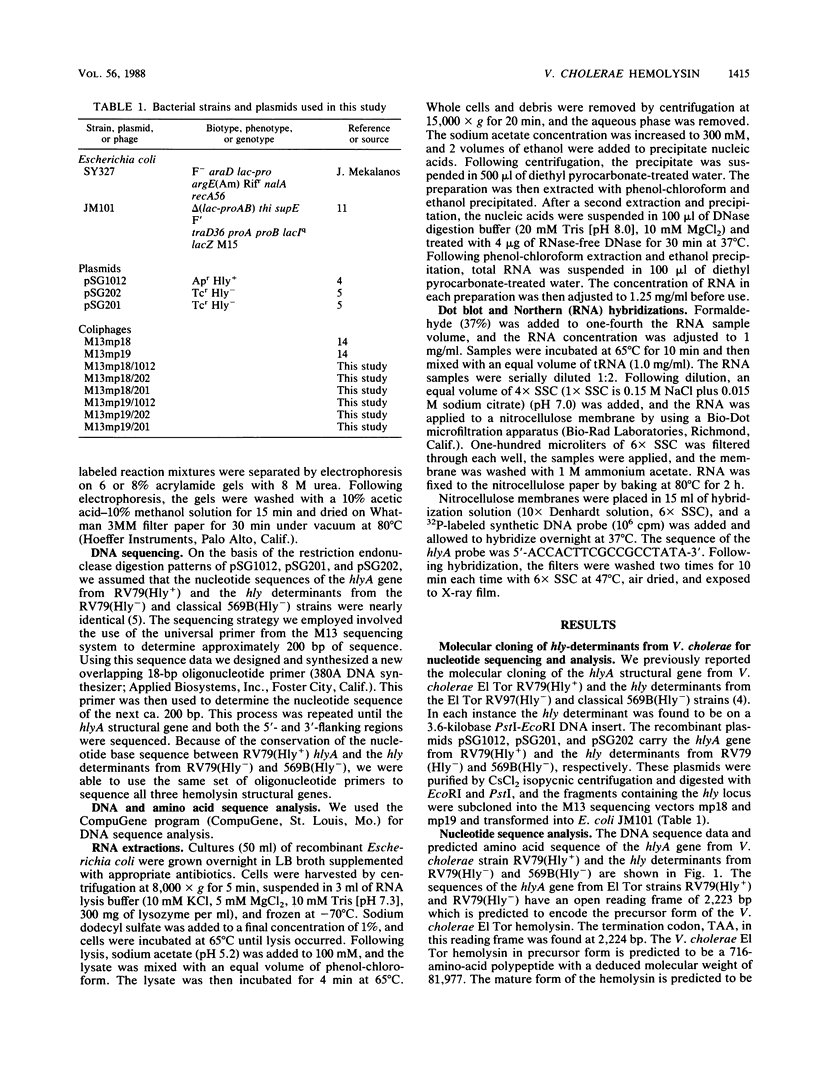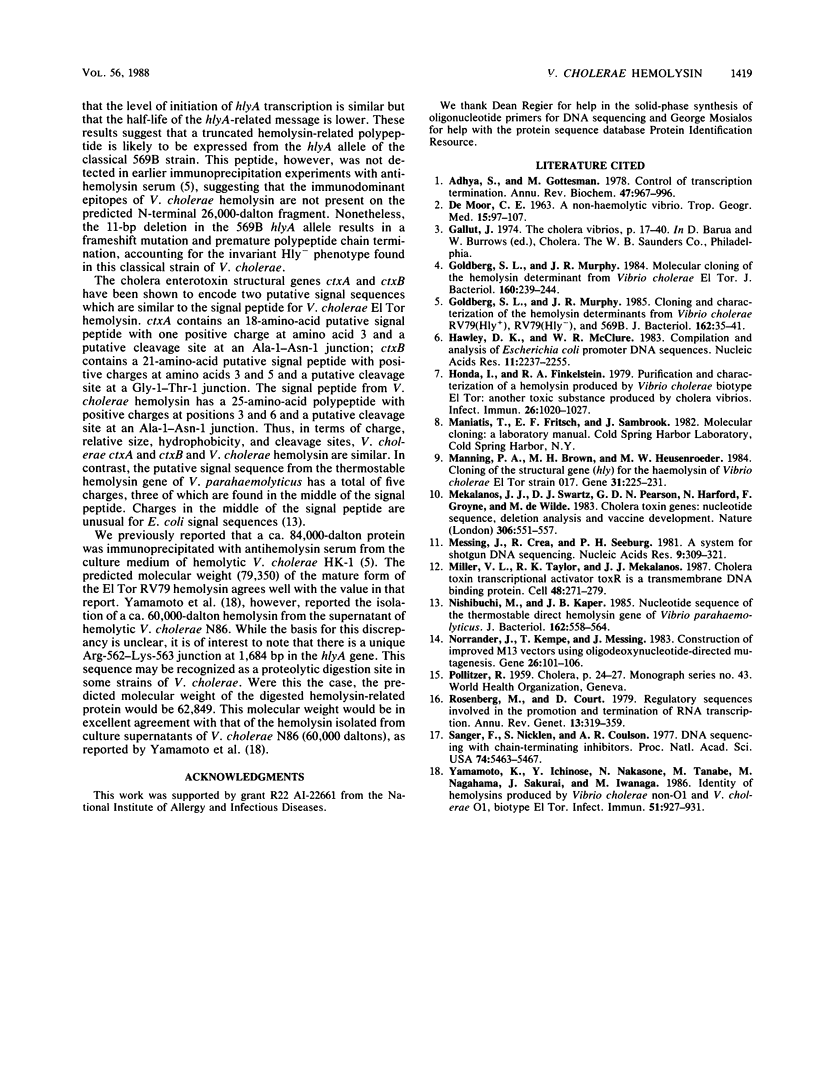Abstract
We determined the nucleotide sequences of the hemolysin structural gene, hlyA, of Vibrio cholerae El Tor biotype strains RV79(Hly+) and RV79(Hly-) and the hly determinant of the nonhemolytic classical biotype strain 569B(Hly-). The sequences of the hlyA gene from El Tor strains RV79(Hly+) and RV79(Hly-) have an identical 2,223-base open reading frame which is predicted to encode an 81,977-dalton precursor form of hemolysin. This value is in excellent agreement with the 84,000-Mr hemolysin described in the earlier report of Goldberg and Murphy (S. L. Goldberg and J. R. Murphy, J. Bacteriol. 162:35-41, 1985). In contrast, the sequence of the hly determinant of the classical 569B(Hly-) strain has an 11-base-pair deletion within the hlyA structural gene. In this instance the hly determinant is predicted to encode a 26,765-dalton precursor form of a truncated hemolysin. In each case, the regulatory region encoding the putative hlyA promoter and the predicted 25-amino-acid signal sequence are identical.
Full text
PDF





Images in this article
Selected References
These references are in PubMed. This may not be the complete list of references from this article.
- Adhya S., Gottesman M. Control of transcription termination. Annu Rev Biochem. 1978;47:967–996. doi: 10.1146/annurev.bi.47.070178.004535. [DOI] [PubMed] [Google Scholar]
- DE MOOR C. E. A NON-HAEMOLYTIC EL TOR VIBRIO AS THE CAUSE OF AN OUTBREAK OF PARACHOLERA IN WEST NEW GUINEA. THE EL TOR PROBLEM AND PANDEMIC PARACHOLERA IN THE WEST PACIFIC. Trop Geogr Med. 1963 Jun;15:97–107. [PubMed] [Google Scholar]
- Goldberg S. L., Murphy J. R. Cloning and characterization of the hemolysin determinants from Vibrio cholerae RV79(Hly+), RV79(Hly-), and 569B. J Bacteriol. 1985 Apr;162(1):35–41. doi: 10.1128/jb.162.1.35-41.1985. [DOI] [PMC free article] [PubMed] [Google Scholar]
- Goldberg S. L., Murphy J. R. Molecular cloning of the hemolysin determinant from Vibrio cholerae El Tor. J Bacteriol. 1984 Oct;160(1):239–244. doi: 10.1128/jb.160.1.239-244.1984. [DOI] [PMC free article] [PubMed] [Google Scholar]
- Hawley D. K., McClure W. R. Compilation and analysis of Escherichia coli promoter DNA sequences. Nucleic Acids Res. 1983 Apr 25;11(8):2237–2255. doi: 10.1093/nar/11.8.2237. [DOI] [PMC free article] [PubMed] [Google Scholar]
- Honda T., Finkelstein R. A. Purification and characterization of a hemolysin produced by Vibrio cholerae biotype El Tor: another toxic substance produced by cholera vibrios. Infect Immun. 1979 Dec;26(3):1020–1027. doi: 10.1128/iai.26.3.1020-1027.1979. [DOI] [PMC free article] [PubMed] [Google Scholar]
- Manning P. A., Brown M. H., Heuzenroeder M. W. Cloning of the structural gene (hly) for the haemolysin of Vibrio cholerae El Tor strain 017. Gene. 1984 Nov;31(1-3):225–231. doi: 10.1016/0378-1119(84)90213-0. [DOI] [PubMed] [Google Scholar]
- Mekalanos J. J., Swartz D. J., Pearson G. D., Harford N., Groyne F., de Wilde M. Cholera toxin genes: nucleotide sequence, deletion analysis and vaccine development. Nature. 1983 Dec 8;306(5943):551–557. doi: 10.1038/306551a0. [DOI] [PubMed] [Google Scholar]
- Messing J., Crea R., Seeburg P. H. A system for shotgun DNA sequencing. Nucleic Acids Res. 1981 Jan 24;9(2):309–321. doi: 10.1093/nar/9.2.309. [DOI] [PMC free article] [PubMed] [Google Scholar]
- Miller V. L., Taylor R. K., Mekalanos J. J. Cholera toxin transcriptional activator toxR is a transmembrane DNA binding protein. Cell. 1987 Jan 30;48(2):271–279. doi: 10.1016/0092-8674(87)90430-2. [DOI] [PubMed] [Google Scholar]
- Nishibuchi M., Kaper J. B. Nucleotide sequence of the thermostable direct hemolysin gene of Vibrio parahaemolyticus. J Bacteriol. 1985 May;162(2):558–564. doi: 10.1128/jb.162.2.558-564.1985. [DOI] [PMC free article] [PubMed] [Google Scholar]
- Norrander J., Kempe T., Messing J. Construction of improved M13 vectors using oligodeoxynucleotide-directed mutagenesis. Gene. 1983 Dec;26(1):101–106. doi: 10.1016/0378-1119(83)90040-9. [DOI] [PubMed] [Google Scholar]
- Rosenberg M., Court D. Regulatory sequences involved in the promotion and termination of RNA transcription. Annu Rev Genet. 1979;13:319–353. doi: 10.1146/annurev.ge.13.120179.001535. [DOI] [PubMed] [Google Scholar]
- Sanger F., Nicklen S., Coulson A. R. DNA sequencing with chain-terminating inhibitors. Proc Natl Acad Sci U S A. 1977 Dec;74(12):5463–5467. doi: 10.1073/pnas.74.12.5463. [DOI] [PMC free article] [PubMed] [Google Scholar]
- Yamamoto K., Ichinose Y., Nakasone N., Tanabe M., Nagahama M., Sakurai J., Iwanaga M. Identity of hemolysins produced by Vibrio cholerae non-O1 and V. cholerae O1, biotype El Tor. Infect Immun. 1986 Mar;51(3):927–931. doi: 10.1128/iai.51.3.927-931.1986. [DOI] [PMC free article] [PubMed] [Google Scholar]




